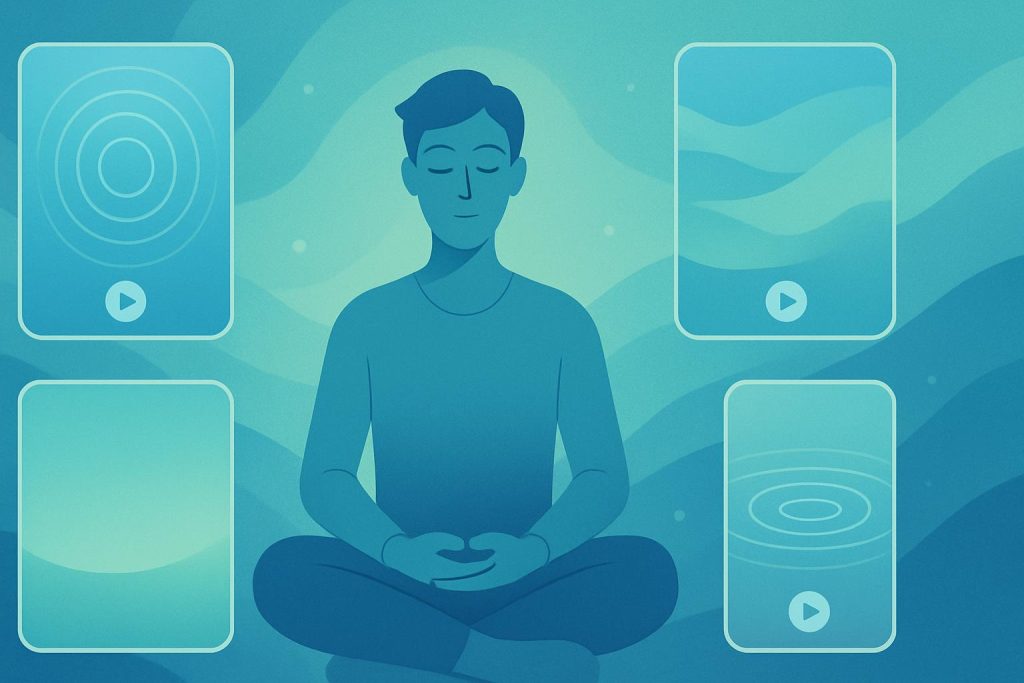In the relentless hum of modern existence, finding moments of stillness and clarity can feel like a Herculean task. The constant barrage of notifications, deadlines, and information overload contributes significantly to stress, anxiety, and a scattered mind, impacting overall mental health as discussed in our main guide: Improving your mental health: strategies and AI tools.
Mindfulness meditation, an ancient practice rooted in present-moment awareness without judgment, offers a powerful antidote. It trains the mind to observe thoughts and feelings passively, fostering a sense of calm, improving focus, and enhancing emotional regulation. While the core principles are simple, establishing a consistent practice can be challenging. This is where technology, specifically artificial intelligence (AI)-powered meditation apps, steps in. These applications leverage AI to personalize guidance, track progress, and make mindfulness accessible to anyone, anywhere, transforming a smartphone into a portable sanctuary for mental well-being.
Mindfulness isn’t about emptying the mind but rather about changing our relationship with it. It involves paying attention to the present moment – sensations, thoughts, emotions – with curiosity and acceptance. Regular practice has been scientifically shown to reduce stress, alleviate symptoms of anxiety and depression, improve attention span, boost memory, and promote emotional resilience. However, beginners often struggle with knowing where to start, maintaining motivation, or finding techniques that resonate.
Traditional methods like attending classes or reading books are valuable, but AI meditation apps provide a dynamic, interactive, and often more convenient alternative. They offer vast libraries of guided meditations, tailored programs for specific goals (like stress reduction or better sleep), and features designed to keep users engaged and consistent.
This article explores the intersection of mindfulness meditation and AI technology, examining how intelligent applications are revolutionizing the way we cultivate inner peace and focus. We will cover:
- The fundamental principles and documented benefits of mindfulness meditation.
- The challenges beginners face in establishing a consistent practice.
- How AI enhances meditation apps: personalization, progress tracking, and engagement features.
- Examples of AI-driven features: adaptive sessions, biofeedback integration (potential), and curated content libraries.
- Spotlight on leading AI-powered meditation platforms like guided meditation mastery with the Headspace partner app and resources explore Mindvalley courses for holistic mental wellness.
- Tips for choosing the right AI meditation app and integrating it effectively into daily life.
By harnessing the capabilities of AI, mindfulness meditation becomes less daunting and more adaptable, empowering individuals to build a sustainable practice that significantly contributes to their mental calm and cognitive focus.
The essence of mindfulness: Presence and acceptance
At its core, mindfulness meditation involves cultivating awareness of the present moment. This can be achieved through various techniques, but common elements include:
- Focused Attention: Directing awareness to a specific anchor, such as the breath, bodily sensations, or sounds. When the mind wanders (as it inevitably does), the practice is to gently guide attention back to the anchor without self-criticism.
- Open Monitoring: Broadening awareness to observe whatever arises in consciousness – thoughts, feelings, sensations – without getting carried away by them or judging them as good or bad.
- Intention and Attitude: Approaching the practice with specific attitudes like curiosity, kindness, patience, and non-striving.
The benefits stem from this consistent training of attention and awareness. By learning to observe thoughts without reacting impulsively, individuals gain perspective and reduce the power of negative thought patterns. Noticing bodily sensations increases interoception (awareness of internal states), which is linked to better emotional regulation. The practice strengthens neural pathways associated with attention control and emotional processing.
Challenges in building a meditation habit
Despite the proven benefits, many people find it difficult to start or maintain a meditation practice:
- Uncertainty: Not knowing which techniques to use or how to perform them correctly.
- Restlessness and Distraction: Finding it hard to sit still or quiet the
mind, leading to frustration.
- Lack of Time: Difficulty fitting meditation into a busy schedule.
- Motivation Dip: Initial enthusiasm waning without clear progress markers or engaging content.
- Finding Relevant Guidance: Sifting through vast amounts of information to find techniques suitable for specific needs (e.g., anxiety vs. focus).
AI-powered meditation apps directly address many of these hurdles.
How AI elevates the meditation experience
Artificial intelligence transforms standard meditation apps into dynamic, personalized guides:
- Personalization: AI algorithms analyze user data (stated goals, mood inputs, session ratings, progress history) to recommend specific meditations, courses, or techniques. Instead of a one-size-fits-all library, users receive curated suggestions tailored to their current needs and preferences. For instance, if a user consistently logs high stress levels, the AI might prioritize calming breathing exercises or body scan meditations.
- Adaptive Sessions: Some advanced apps use AI to adjust the guidance during a session based on real-time (or inferred) user state. While direct biofeedback integration (using wearables to measure heart rate variability, etc.) is still evolving, AI can infer engagement or restlessness from interaction patterns and subtly modify pacing or instructions.
- Intelligent Progress Tracking: AI goes beyond simple streak counts. It can analyze consistency patterns, identify correlations (e.g., “meditating in the morning correlates with higher reported focus”), and present progress in visually engaging ways, providing objective feedback that fuels motivation.
- Curated Content Discovery: AI helps users navigate vast content libraries by intelligently recommending relevant meditations, talks, or music based on their history and stated interests, preventing overwhelm and facilitating exploration.
- Chatbot Guidance & Support: Some apps incorporate AI chatbots that can answer questions about techniques, offer encouragement, or provide brief, guided exercises on demand, offering support outside of formal meditation sessions.
- Gamification and Engagement: AI can personalize challenges, milestones, and rewards systems to keep users motivated and make the practice feel more engaging, particularly for those new to meditation.
Spotlighting AI-driven platforms
Several platforms exemplify the power of AI in mindfulness:
- Headspace: A pioneer in the field, guided meditation mastery with the Headspace partner app utilizes AI extensively to personalize user journeys. It recommends daily meditations, themed courses (on stress, sleep, focus, etc.), and shorter exercises based on user input and progress. Its vast library is curated and suggested intelligently to match individual needs.
- Mindvalley: While broader than just meditation, explore Mindvalley courses for holistic mental wellness. offers numerous programs focused on mindfulness, meditation, and mental well-being, often incorporating personalized learning paths and community features potentially enhanced by AI algorithms to guide users through extensive personal growth content.
These platforms demonstrate how AI can create structured, supportive, and highly personalized environments for learning and practicing mindfulness.
Choosing and integrating your AI meditation companion
With numerous options available, consider these factors when selecting an app:
- Content Variety and Quality: Does the app offer a wide range of guided meditations, courses, and techniques led by experienced instructors?
- Personalization Features: How well does the app tailor recommendations and experiences to your specific goals and progress?
- User Interface and Experience: Is the app intuitive, calming, and easy to navigate?
- Tracking and Analytics: Does it provide meaningful insights into your practice and progress?
- Cost and Subscription Model: Understand the pricing structure (free trials, subscriptions, lifetime options).
- Privacy Policy: Ensure the app has clear and robust data privacy practices.
Integrating the App Effectively:
- Start Small: Begin with short sessions (5-10 minutes) and gradually increase duration.
- Be Consistent: Aim to practice at the same time each day to build a habit.
- Create a Dedicated Space: Find a quiet place where you won’t be interrupted.
- Be Patient and Kind: Don’t get discouraged if your mind wanders. Gently guide it back.
- Explore Different Techniques: Experiment with various types of meditation (breath focus, body scan, loving-kindness) to find what resonates.
- Use Reminders: Leverage the app’s reminder features initially.
- Reflect on Insights: Pay attention to the progress data and correlations the app provides.
AI as a catalyst for inner calm
Mindfulness meditation is a potent tool for enhancing mental well-being, fostering calm, and sharpening focus in a demanding world. While the practice itself is timeless, AI-powered applications have emerged as powerful catalysts, making mindfulness more accessible, personalized, and sustainable. By leveraging intelligent algorithms, apps like Headspace and platforms offering courses like Mindvalley provide tailored guidance, track progress meaningfully, and keep users engaged.
They effectively lower the barrier to entry and address common challenges faced by beginners. When chosen carefully and integrated thoughtfully into a daily routine, these AI tools can serve as invaluable companions on the journey toward greater presence, emotional balance, and mental clarity, complementing the broader strategies for mental health outlined in our pillar article.



